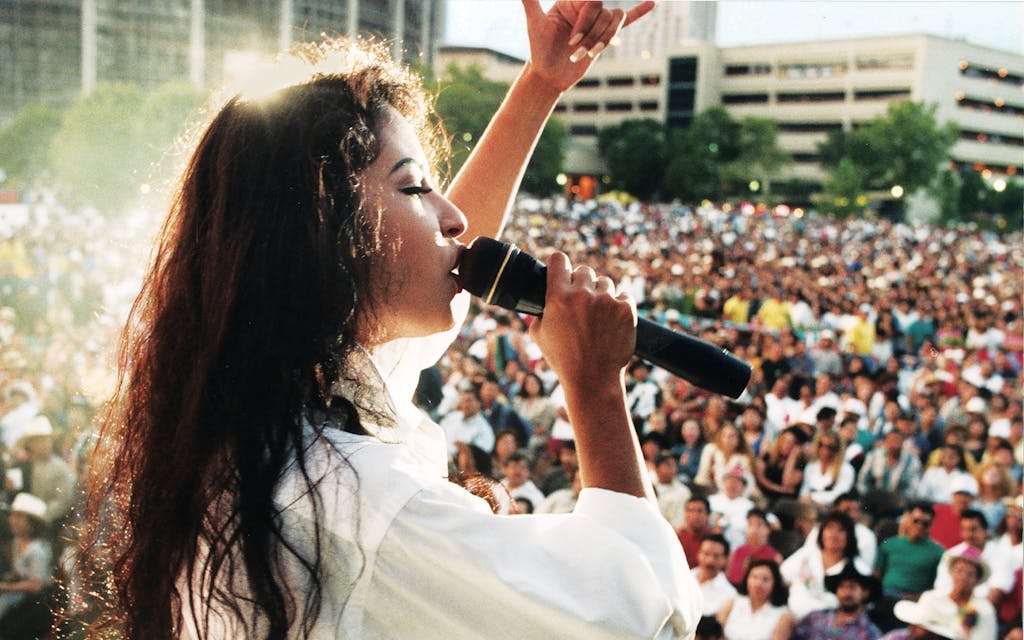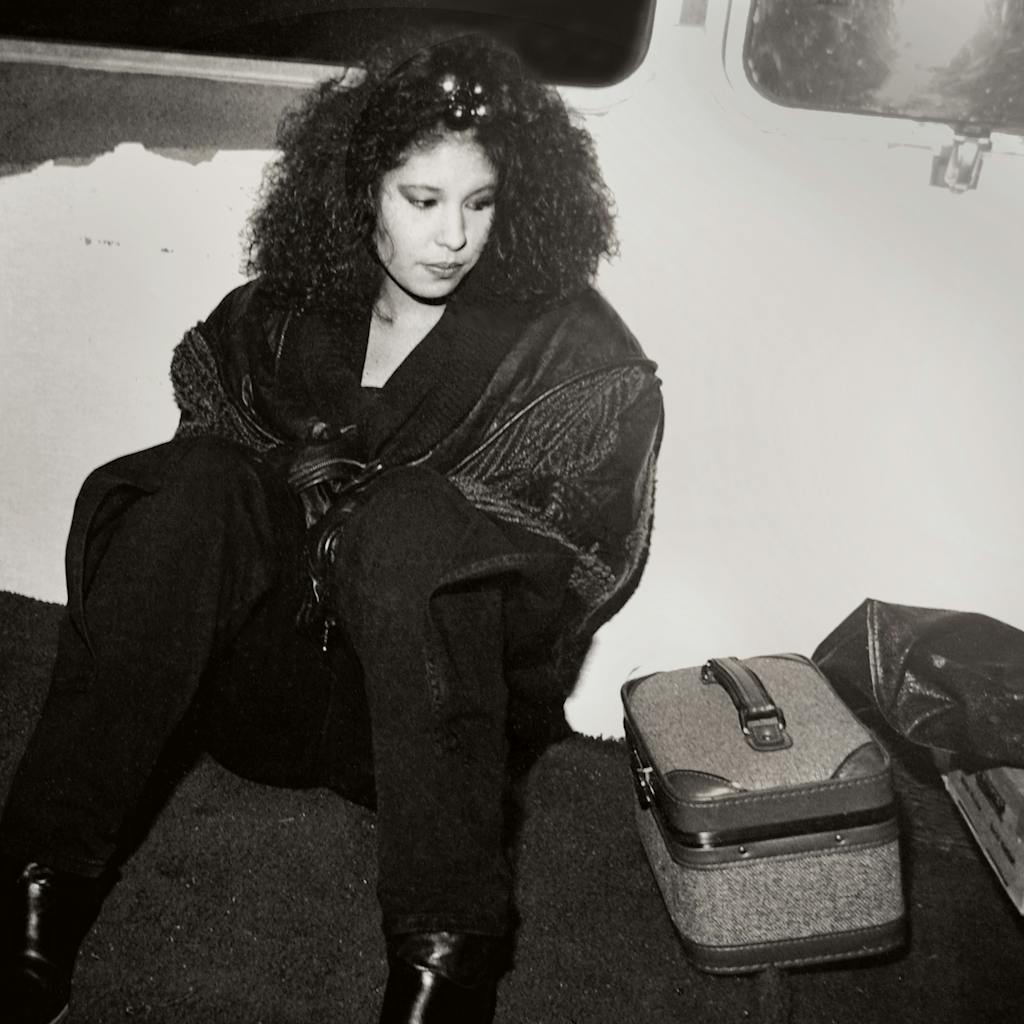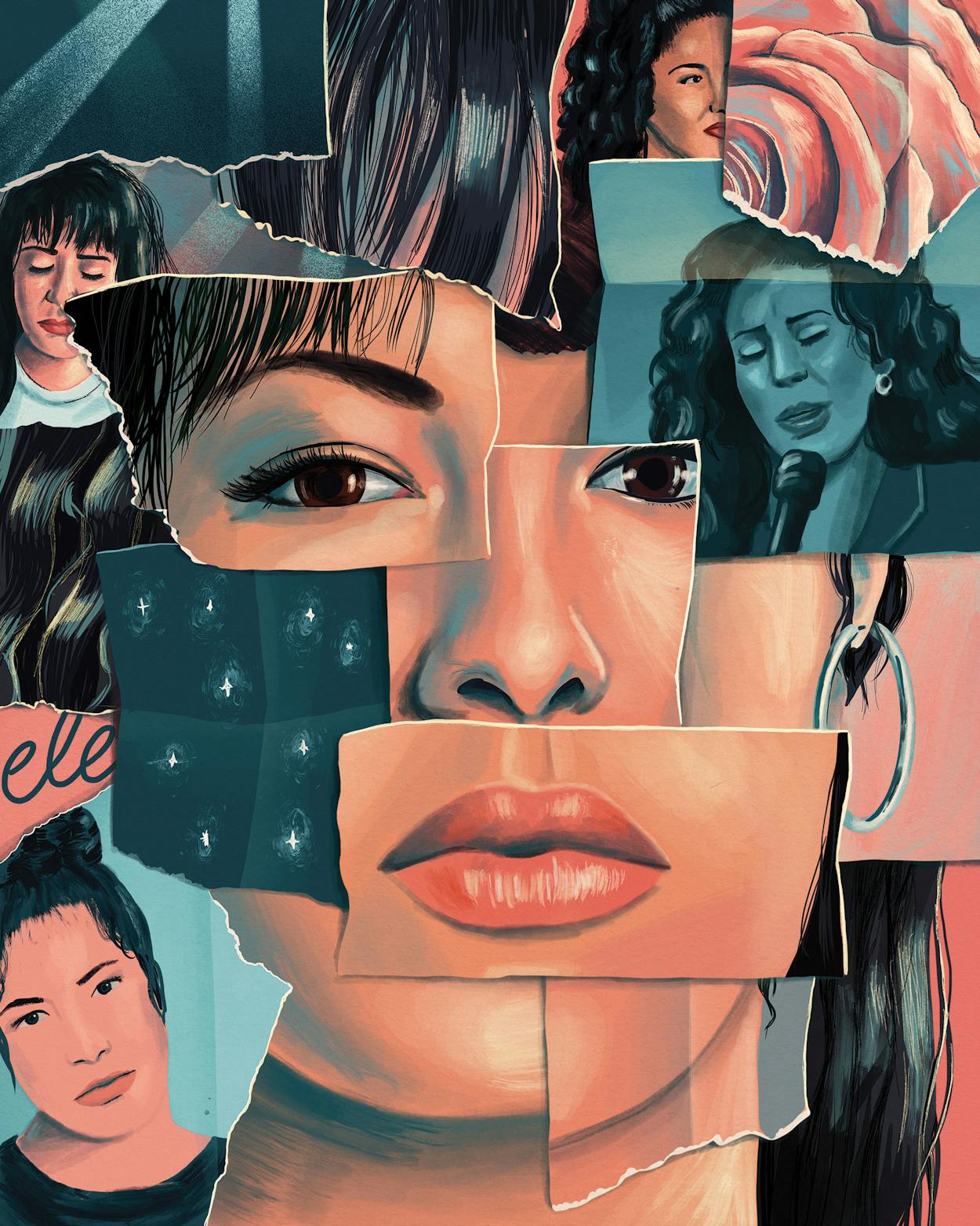In the days following my grandpa’s death in 2019, I searched his house for old photographs. My family was putting together a slideshow to play at his funeral, and I wanted to find pictures that would remind attendees of the incredible life he had lived: snapshots of him posing with the lions and hippos he cared for at the San Antonio Zoo, training polo ponies in Tennessee, and relaxing at his parents’ home back in Mexico.
In an old dresser at the back of the house, I stumbled upon a worn leather book filled with photos, a handful of which fell to the floor when I opened it up, the adhesive long since dried out. I found myself gazing at images of two family dogs, Chaquira and Spudsie, that were long gone and of my cousins riding horseback at my grandpa’s ranch.
And then, toward the back of the album, I came across clippings from People and the San Antonio Express-News, all of them featuring Selena, all dated from the days and weeks after her death. In practically every shot she had a microphone in hand, and her dazzling smile lit up the page. “Thousands of fans mourn Selena,” read one headline. “Tejano artist’s potential to remain unrealized,” read another.
Drowning in waves of despair over my grandpa’s death, I was desperate for a distraction. So I sat there at his kitchen table and pored over those stories. I recognized the grief in the faces of young fans sobbing by the chain-link fence that surrounded Selena’s Corpus Christi home and clutching the black marble bench at her grave site.
Studying these images of mourning felt strangely comforting. My grandpa’s death was a loss so profound that I wasn’t sure I would ever recover. But those forgotten articles, by then more than two decades old, made clear to me that there is life after death and power in remembering. And for what felt like the thousandth time, Selena had found me right when I needed her.
In Mexican families, the dead never die. Long after our friends and relations have passed on, we will them back into existence by telling their stories, by transforming their lives into folklore, and by building altars to their memories so that their spirits remain with us.
I was born in 1996, a year after Selena’s death and a year into her sainthood. I don’t remember who first told me about her or when I listened to her music for the first time, but it felt like she was always there, playing in the background while my family members and I browsed the aisles of the Handy Andy supermarket and during drives with my tías and tíos. For a few years, I had no idea where she was from or what had happened to her. I just knew she felt familiar.

There’s a scene in Lourdes Portillo’s 1999 documentary Corpus: A Home Movie for Selena, in which she homes in on a group of young girls studying at the Tejano Academy of Fine Arts in Corpus Christi. One student wears a crop top along with a slicked-back bun and a hint of red lipstick, resembling a miniature Selena. Around her, about a dozen other Latinas with long, dark hair take turns hopping on the stage, singing in English and Spanish while they twirl around the room. They sometimes lock eyes with Portillo’s lens, confidently attempting to attack each note with the same passion and power for which Selena was known. The scene was filmed around 1998, just three years after the musician’s death. Watching it today, it’s striking how little has changed. Portillo has yet to see a celebrity speak to Latinos in quite the same way. “There have been other Latina singers and stars, but no one with the magnitude and charisma she had,” Portillo tells me. “She had a tenderness that made girls see themselves in her. They saw the possibility of being Selena.”
At Las Palmas Elementary on the West Side of San Antonio, my classmates and I often swapped rumors and stories about Selena, piecing together what had happened to her from whispered conversations we overheard at home about her violent death. By the fourth grade, we knew the basics: Selena was a shining light, a once-in-a-lifetime talent—and one of us. She was a girl from the barrio, from South Texas, where she and her siblings had started a band together. She sang in English and Spanish and danced around the stage in marvelous, glittering outfits. She was the Mexican Madonna; she was La Reina; she was on the verge of accomplishing things that no other Mexican American singer ever had. And then she was killed, taken from the people who loved her by one of her biggest fans.
Her ascendance didn’t happen in a vacuum. Throughout the nineties and early aughts, an increase in illegal immigration prompted waves of anti-Latino sentiment and anti-immigrant legislation across the country. Those attitudes served as the backdrop for Selena’s rise to fame and amplified the grief following her loss. In her 2009 book, Selenidad: Selena, Latinos, and the Performance of Memory, the San Antonio–born cultural critic Deborah Paredez explores Selena’s impact on Latino communities. “Even as Latinos mourned her tragedy, she represented possibility,” Paredez says. “The hope that perhaps things would get better for Latinos.”
But in the sixth grade, my family moved to Fair Oaks Ranch, on the outskirts of San Antonio, and I learned that the connection I’d felt to Selena wasn’t universal. I went from a majority Hispanic city to a suburb where Hispanic residents made up little more than 10 percent of the population. From the first day of school, I was made keenly aware of my ethnicity. Teachers and students stumbled over my last name. The normalcy of my family suddenly seemed abnormal; while my classmates might have visited a few of their relatives over summer break, my “immediate” family consisted of at least twenty people—aunts, uncles, and cousins who all lived within a thirty-mile radius of each other and saw one another every week. And I was sure that my grandpa’s signature dishes (especially his menudo) would have been enough to scare off most of my peers. I felt lost.
Around that time, YouTube was becoming more popular. For the first time, I could watch compilations of Selena’s legendary performances online whenever I wanted to and could listen to her goof around in behind-the-scenes footage and talk show interviews. In one snippet, captured between takes for the video of “No Me Queda Más,” she sassily introduces the director, Sean Roberts. “Little does he know, I call the shots,” she says with a cheeky grin, explaining that production had temporarily come to a halt in order to find one of her treasured white roses—an example of how every little detail had to match her vision.
In another video, from her 1995 performance of “Baila Esta Cumbia” at the Houston Livestock Show and Rodeo, her dancing is relentless. She makes ample use of her hips, spinning back and forth under the spotlight while executing flamenco-inspired gestures with her hands. I was in love with the way that she moved, acutely aware of my own awkwardness and envious of the command she had over her body. And when I listened to her talk, she sounded like one of my friends from San Antonio.
Throughout my suburban exile, Selena was my life raft. I clung to her for support when it felt as though I was losing touch with myself. I spent six days of the week in Fair Oaks Ranch, where I learned the lyrics to Taylor Swift and Paramore songs and grew deeply invested in the drama between Nick Jonas, Miley Cyrus, and Selena Gomez. But on Sundays, I returned to San Antonio’s West Side, where my aunts and uncles gently teased me and said I was forgetting my Spanish.
During my junior year of high school, when I enrolled in advanced Spanish, something changed. I finally met friends who didn’t need my help conjugating verbs, who knew Selena’s entire discography and introduced me to songs of hers I’d never heard. On a break, our teacher let us walk around outside and I heard “El Chico Del Apartamento 512” and “Tus Desprecios” for the first time, trying to get my mouth to form the words as quickly as Selena’s did.
Selena has a way of making you feel seen, but also of feeling so completely out of your league that you want to figure out how to be her. She became my teacher. I practiced her songs in choir rooms, learning new Spanish words. I was particularly captivated by her performance at Fiesta Broadway in 1992, where she demonstrated how fluent she had become at Janet Jackson– and Paula Abdul–style footwork; I spent months trying to learn her moves, dances I would never have asked someone to teach me. Occasionally, I shared her songs with my non-Latino friends, convinced that I was going to open up a whole new world to them, only to be told that they just didn’t get it.
When I went to college in Austin and was away from my family for the first time, Selena’s voice was again a guiding presence that pushed me to go for bolder looks: to wear red lipstick, to put on hoop earrings, to seek out attention and not be afraid if someone gave it to me. Texas’s capital city had more Latinos than Fair Oaks Ranch, but it still wasn’t San Antonio. During my first few years there, I’d get in my car and drive around town, blasting Selena’s greatest hits as I scoured East and South Austin for panaderías and fruterías. With each drive, the city felt a little bit more like home.

In that leather scrapbook in my grandpa’s house, I encountered a folded page from the Sunday, April 2, 1995, edition of the Express-News. As I carefully peeled it out, a headline caught my eye: “Neighbors saw role model in girl from Molina.” Selena’s power stemmed from the fact that she was a real person. All of her otherworldly talent was wrapped up in a human being. She practiced, she worked, she grew frustrated with record label decisions and the delay of her English crossover album.
In the days after her death, as reporters walked through the working-class streets of Molina, they came to understand why there were lines of cars filled with people who had driven hours to leave mementos outside of her house. Her star had been on the rise for years, but she had stayed in the neighborhood, recruiting kids to help with yard work or to track down her dog when it got loose. Between gigs, she made appearances at local schools, encouraging young fans to stay focused on their studies. “She was still a Molina girl,” said Corpus Christi high school principal Danny Noyola, “somebody who doesn’t forget where they come from.”
When I was a child, 23 seemed well on the far side of adulthood. I imagined it as the age when you got married, bought a house, and maybe started a family. Selena’s death at 23 was heartbreaking, but I felt sure that she had gotten a taste of freedom, a brief chance to live before her life was cut short.
Now that I’m 24, Selena at 23 feels impossibly young. Too young to have the pressure of international stardom on her shoulders, too young to think about what she had to give up to achieve it, too young to be turned into a martyr.
Yet she became one, or whatever other label of reverence you might want to put on her: a saint, a queen, a symbol, a role model. Coming along as I did, after her death, I’ve only ever known her as an icon, as something bigger than herself. That’s understandable, given that she died so early in her career and with so much of her story unfinished; it’s no wonder that those of us who were devoted to her filled those gaps with our adoration.
But the problem with sainthood is that it has made the real Selena less tangible. In the early nineties, Selena was doing something radical. She wasn’t sacrificing the imperfect or less commodifiable parts of herself to rise through the ranks; she was putting them on full display for everyone to see. She embraced her Mexican heritage at a time when Latinos were under pressure to assimilate. She didn’t hide from her fans on the other side of the border that her Spanish was far from perfect. She designed outfits that showed off her curves and challenged mainstream standards of beauty.
Last year, when Selena: The Series premiered on Netflix, fans expressed outrage at the portrayal of a meek young woman who sat back as her brother, A. B., and her father, Abraham, made decisions for her. It ran counter to everything so many Latinas had come to love about Selena. She wasn’t just a singer or a fashion icon; she was an enterprising woman making her way in a culture that was—and is still—dominated by men. In that sense, maybe she was a saint—because saints aren’t usually passive or peaceable. They’re fierce to their cores.
While most of us recognize Selena’s tenacity, though, that halo we’ve placed above her head has turned her into an infallible figure she never pretended to be. To truly understand what was lost when Selena died, new generations of fans need to see her as a person, not a myth.
Selena left us when she was still inventing herself, when she hadn’t made any major missteps. She’s forever frozen in amber on the precipice of superstardom, having rarely, if ever, failed at anything.
But if we’re going to honor Selena—the real Selena—and find a way to carry her with us as we move through our own lives, then we need to imagine what she might have done if she had lived a full one. That, too, is a way of ensuring the dead never die. She would have doubtless gone on to greater heights. She might have become an actress, or a heavy hitter in the international fashion world; she might have headlined a Super Bowl halftime show. In a bid for relevancy later in her career, she might have also released a trap album. Or recorded a duet with Adam Levine. Or appeared in Gal Gadot’s “Imagine” video. Because she was human, she would have inevitably made some mistakes. And that would have forced us into a more nuanced and complicated relationship with her.
In this, I’m reminded of my grandpa. Though I see in him many of the same things I see in Selena—a resolute will to succeed against the odds, abiding loyalty to his family, and pride in his roots on both sides of the border—he was also completely unlike her. He lived to be 89 years old, and when I think of him, it’s not just of the heroic younger years I heard so many stories about, but of the decades that followed, the years I witnessed. I saw him experience grief and frailty. I watched his temper flare. I saw his pride cloud his judgment. As much as I loved him, I know that he sometimes let his loved ones down.
Selena never got the chance to disappoint us. But if she had lived long enough, she surely would have. And we would have had to struggle to love her. Which is a different kind of love, and maybe a better one.
This article originally appeared in the April 2021 issue of Texas Monthly with the headline “Selena, Role Model.” Subscribe today.
- More About:
- Music
- Selena
- San Antonio
- Corpus Christi









